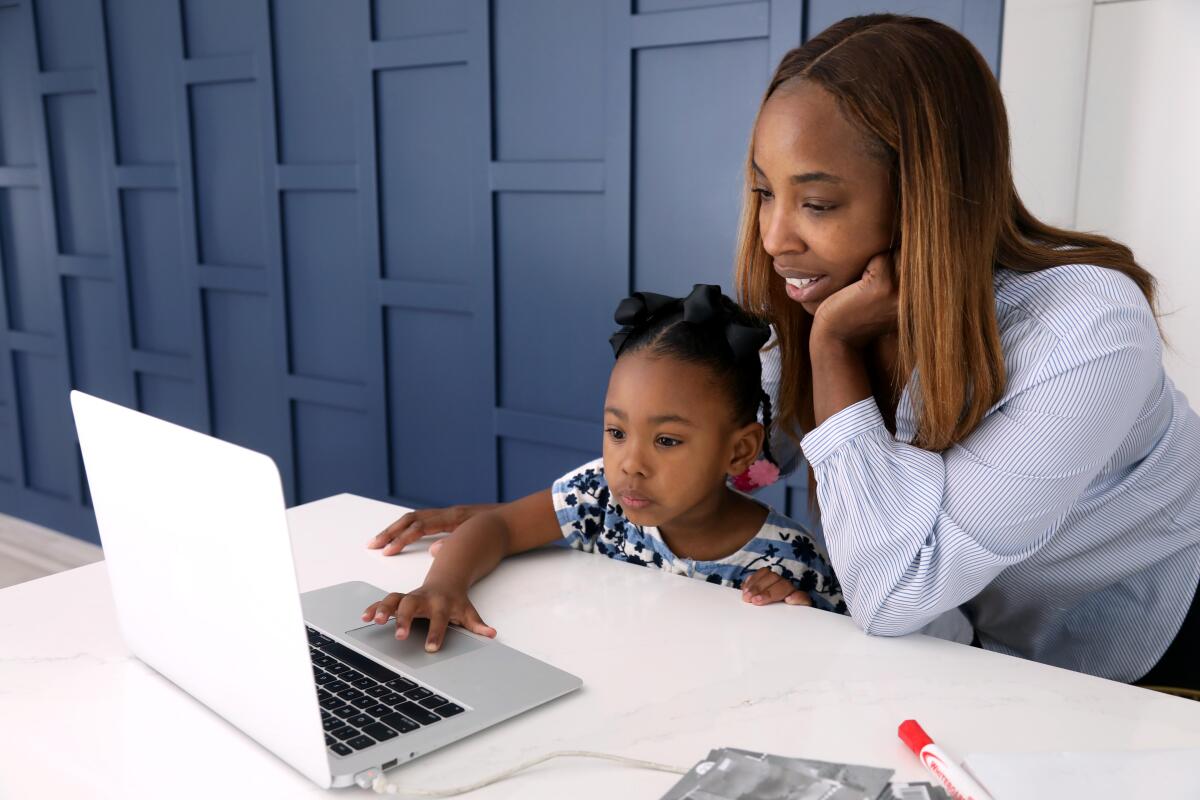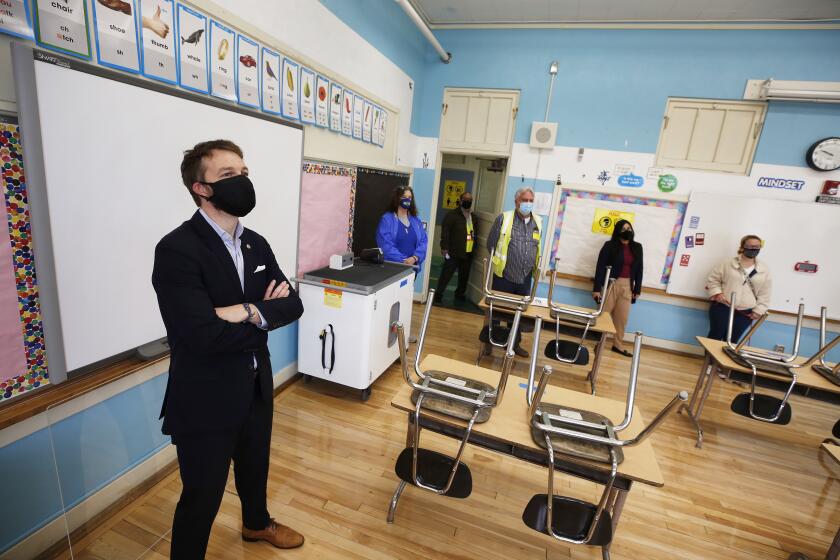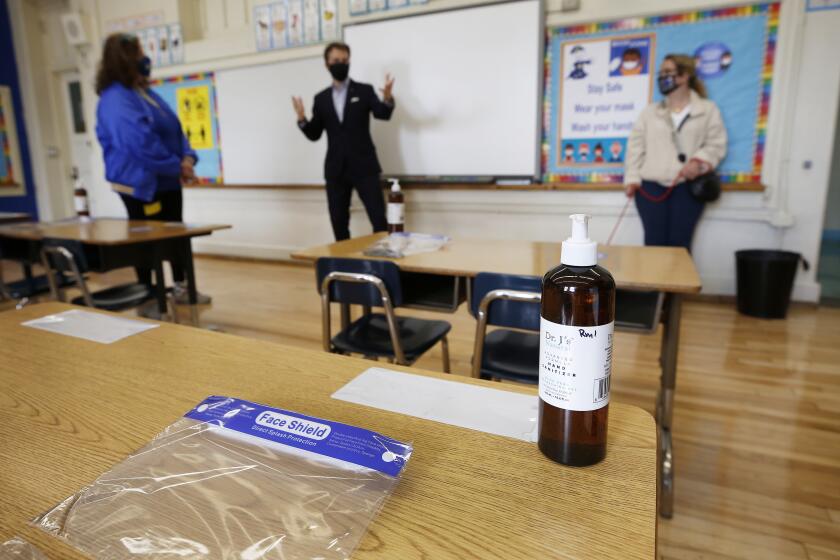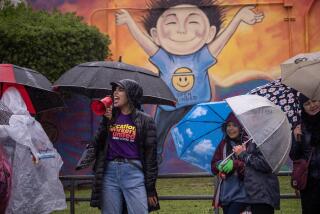When LAUSD reopens schools, K-8 students will spend more time in child care than class

- Share via
Like most Los Angeles Unified School District students returning to campus this month, kindergartner Cali Corbin will spend the bulk of her day in “supervised care and enrichment” — free school-site programming for the hours she’s not with her teacher.
For the vast majority of returning elementary schoolers, that means from the end of in-person instruction at 11 a.m. until 4 p.m. For a much smaller number, it may be from 8 a.m. until lunch. And for middle schoolers, it could be several full days a week, from 8 a.m. until 4 p.m.
For the record:
9:10 a.m. April 13, 2021An earlier version of this article attributed a statement from United Teachers Los Angeles to UTLA spokeswoman Kim Turner. The statement was by UTLA President Cecily Myart-Cruz.
In all cases, supervised care, not instruction, will make up most of the school day. And for parents like Cali’s mom, Renee Bailey, those extra hours are essential.
“Parents are asking for child care because we’re working,” the South L.A. mom said. Although the majority of LAUSD students will remain remote for the rest of the school year, families who do plan to return say the truncated instruction schedule would be impossible to manage without the extra hours of care the district has promised them.
But while the precise details of face-to-face instruction have been bargained and debated in public for weeks, the parameters of this extended care remain largely unknown. District spokesperson Barbara Jones said non-instructional time will include “one-on-one tutoring, recess, lunch and extracurricular activities like painting, dance and yoga,” and that it will take place in libraries, classrooms, or enclosed tents with power generators and ventilation fans.
Like instruction, child care must adhere to the six-foot social distancing rule. Beyond that, few details have emerged. But providers for more than 400 district schools said the logistics were so complex they weren’t sure how the promised program would work.
Indeed, few knew it existed until Supt. Austin Beutner announced it publicly last month.
As of now, all elementary and middle school students who want it are entitled to some form of adult supervision at school for eight hours a day, five days a week. (No similar plan exists for high schoolers, who will spend two to three days a week on campus.) District and community-based providers, including nonprofits, city agencies and LAUSD itself, are hiring thousands of workers to supply that care, at rates from around $14 an hour to $30 or more.
Health checks, coronavirus testing and social distancing are part of LAUSD’s school reopening plan.
Pre-pandemic, these groups mostly ran after-school programs, working under the auspices of LAUSD’s Beyond the Bell. They’re old hands at the kind of social-emotional learning experts say students need. Most have been hosting in-person enrichment and remote learning support since last summer.
“Way before the vaccines were available, we were in person with students,” said Eric Gurna, president and chief executive of the nonprofit after-school program L.A.‘s Best, which will provide care at almost 200 district schools. “Our staff have been putting themselves at risk through the whole past year. Now our staff is prepared to go back in a very stressful, dynamic, uncertain situation, and there’s a lot we still don’t know.”
A small number of elementary school students will return to campus on Tuesday, with the majority following on Monday. Middle schoolers will return the following week. Yet by mid-month, providers had only a rough guess of how many children they would be serving. LAUSD estimates that more than 70% of returning grade schoolers and about 64% of returning middle schoolers will stay for extended-day care, but total numbers continue to fluctuate. It’s also unclear where their care would take place — not to mention how students would be transported in cases where there’s simply no room at the school.
“Logistically there’s a whole bunch of moving parts that we’re trying to navigate with incomplete information,” said Kim Richards, chief executive of the Boys & Girls Clubs of Carson, which will provide care for about 50 LAUSD schools. “On some campuses we’re likely going to be in tents — but that’s really dependent on how many parents are going to send their kids back, and how many have not indicated anything at all, but just plan on showing up.”
Meanwhile, rules about how many children from different classrooms can mix in aftercare and what school spaces might be available to them have continued to change almost daily, and sometimes hour by hour. With days to go before the first elementary school students return, it was still unclear if enrichment programs could serve food, or even allow it — a major departure from typical after-school programs, which serve snacks and in many cases meals.
“I do foresee that coming back, but in which way we don’t know yet,” L.A.’s Best’s Gurna said.
It was also not immediately clear how labor laws would square with public health rules.
After-school programs typically run three to three-and-a-half hours. But extended care will be four or more, which means, by law, every worker needs a break. Hiring a floater to relieve them could stretch public health rules that mandate only two adults interact with each stable group of 14 children in a given day.
“It’s not just enough to say, ‘Oh, we have to do whatever it takes to serve these kids’ — we also have to comply with the labor laws, the health guidelines,” Richards said. “It’s a logistics nightmare.”
The logistics are most daunting at the most affluent schools.
It’s long been clear that students on the Westside and parts of the San Fernando Valley were coming back to campus in much larger numbers than those elsewhere. That means at least some of those elementary schools will have to run in-person classes after lunch. It also means they’ll need two shifts of extended care — one in the morning and a second in the afternoon.
But scores of these schools had no formal after-school program pre-pandemic and so no contracted provider to tap for extended care now. To make matters more difficult, the funding structure for expanded care is murkiest where it’s most in demand.
Most LAUSD schools fall under Title I, a federal designation for high-poverty schools that entitles them to state and federal funding for after-school programs — cash they can easily shift into extended care. But that’s not true of the schools with the greatest demand for in-person instruction, and therefore for supervision and enrichment. While COVID relief and school reopening funds from California’s Assembly Bill 86 and the federal government might make up the difference, some worry about the optics of funneling that money to the most privileged students.
“It’s extremely frustrating,” said Bailey, the South L.A. mom, whose daughter attends Westwood Charter Elementary School, where 91% of students plan to return. “If we were following CDC guidelines, all students would be able to return to campus, and we wouldn’t have this issue.”
This has been one of the loudest public criticisms of LAUSD’s care and supervision program so far: that it would be irrelevant if teachers agreed to the newest public health guidance for social distancing, which recommends three feet in schools, rather than the six feet their union bargained for.
Students can sit three feet apart in classrooms, instead of four or six, potentially allowing schools to avoid hybrid, part-time schedules. L.A. Unified will stick with six feet.
“The CDC’s erosion of safety standards to three feet flies in the face of overwhelming evidence that COVID is airborne,” UTLA President Cecily Myart-Cruz wrote in a statement. “The agreement with the district will help protect students and educators and make families feel safer about returning their students to in-person learning.”
California districts so far have split over the six-feet rule. But for teachers to return at six feet and not three, other workers had to fill in the gaps with extended care, since only about half the students can be in class at a time. Under the current plan, these workers will spend roughly twice as many hours per week face-to-face with students as district teachers do. And with the majority earning between $15 and $18 an hour, LAUSD’s child-care providers make far less than the educators whose labor they replace.
“It’s a continuation of what we’ve seen throughout the pandemic,” with lower-paid child care replacing higher-paid educational work, said Marcy Whitebook, founder and co-director of the Center for the Study of Child Care Employment.
For the better part of a year, child-care programs around L.A. County have been filled with remote learners, most of them children of essential workers, almost all of them cared for by working-class women of color with few benefits, minimal job protections and, until last month, no vaccines. By contrast, LAUSD teachers are more than a third white, and all make middle-class salaries with jobs protected by a union that negotiated their right to work from home until they were inoculated.
“The reality is that teachers are also caregivers, and people who do child care are [also] educators,” Whitebook said. “You’re seeing a disparity about how we value these jobs.”
More to Read
Sign up for Essential California
The most important California stories and recommendations in your inbox every morning.
You may occasionally receive promotional content from the Los Angeles Times.













